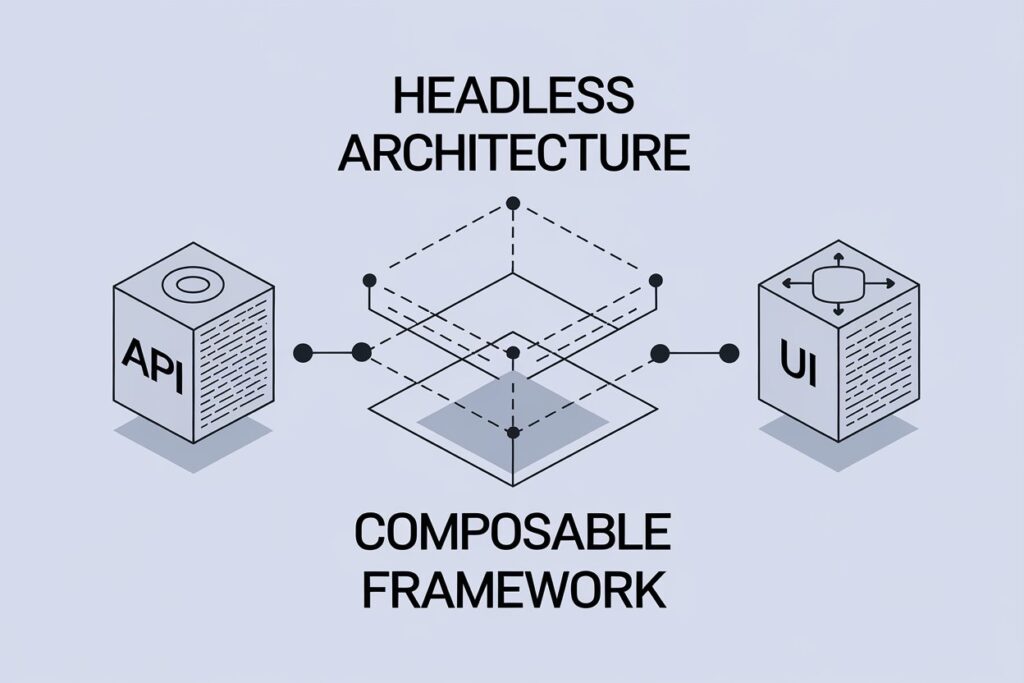In the rapidly evolving landscape of eCommerce, businesses are increasingly turning to headless architecture as a means of future-proofing their platforms. But what exactly does this term mean? In traditional web development, the “head”—or front-end—is tightly coupled with the “body”—or back-end. This limits flexibility and makes it difficult for businesses to adapt quickly to changing consumer needs.
Headless architecture changes this by decoupling the front-end and back-end, allowing each part to operate independently. This means you can deliver rich, customized user experiences across multiple touchpoints like websites, mobile apps, or even IoT devices without being limited by a monolithic system.
In headless architecture, the front-end communicates with the back-end via APIs, making it easier to integrate new technologies or features without disrupting the entire system. For businesses looking to stay agile in an ever-changing market, this approach is gaining traction.
Understanding Composable Frameworks
While headless architecture offers flexibility, a composable framework takes this concept a step further. In a composable framework, the entire eCommerce stack is built using modular, interchangeable components.
Each component—whether it’s the CMS, payment gateway, or product catalog—operates independently but works together harmoniously to create a seamless system. This approach is highly customizable, enabling businesses to tailor their technology stack based on specific needs rather than being tied to a single, monolithic platform.
Think of it like building with LEGO blocks: each piece is an independent unit, but together, they form a complete and functional structure. This modularity empowers businesses to choose the best-in-class tools and services for each part of their eCommerce operations, making it easier to scale or modify as the business grows.
Key Differences Between Headless and Composable Frameworks
While headless architecture and composable frameworks share a lot of common ground, they aren’t the same thing. Let’s break down the key differences:
- Scope: Headless architecture focuses primarily on decoupling the front-end from the back-end, while composable frameworks extend that concept to the entire system, breaking it down into modular components.
- Flexibility: Both approaches offer flexibility, but a composable framework provides an added level of customization, as businesses can mix and match components according to their needs.
- API Usage: In headless architecture, the back-end communicates with the front-end via APIs. In a composable framework, APIs enable communication between all components, from CMS to payment processing.
Benefits of Adopting Headless Architecture and Composable Framework
Why are so many businesses making the shift to headless architecture and composable frameworks? Here are some of the most significant benefits:
- Increased Flexibility: With a headless and composable approach, businesses aren’t locked into a single platform. They can swap out components without having to rebuild the entire system.
- Better User Experience: Since front-end and back-end operate independently, businesses can optimize the user experience without worrying about affecting the back-end infrastructure.
- Faster Time to Market: By using modular components and APIs, businesses can integrate new features or technologies quickly, reducing time to market for new projects or updates.
- Scalability: Composable frameworks allow for easy scaling as each component operates independently. You can upgrade or replace a specific part of the system without downtime or complicated migrations.
- Lower Costs in the Long Run: Although initial setup might require a higher investment, the long-term benefits in terms of reduced development time and flexibility make this approach cost-effective.
How Headless BigCommerce Fits into This Framework
Headless BigCommerce is an excellent example of how businesses can leverage headless architecture to enhance their operations. BigCommerce provides a flexible, scalable platform that integrates seamlessly with headless setups, allowing businesses to decouple their front-end without compromising on eCommerce functionalities.
Whether you’re looking to build a custom mobile app or deliver a unique experience across different devices, Headless BigCommerce offers the tools and APIs needed to create a truly omnichannel eCommerce solution. Businesses can adopt best-in-class solutions for each component, from CMS to checkout, all while benefiting from BigCommerce’s powerful back-end features.
How to Hire BigCommerce Developers for Headless Solutions
Implementing headless architecture and composable frameworks requires expertise. This is where the decision to hire BigCommerce developers becomes crucial. Specialized developers who understand the intricacies of headless and composable systems can help integrate BigCommerce into a decoupled architecture, ensuring that your business maximizes the benefits of this modern approach.
When looking to hire BigCommerce developers for a headless project, consider the following:
- Experience with API integration: Developers must be adept at working with APIs, as this is the backbone of headless architecture.
- Familiarity with composable frameworks: A good developer should understand how to implement modular systems, allowing your business to use best-in-class solutions for each function.
- Custom Development: Look for developers with experience in custom solutions, as headless architecture often involves tailored front-end development to meet specific business needs.
Conclusion
In today’s dynamic eCommerce landscape, adopting headless architecture and a composable framework is no longer just an option but a strategic necessity. By decoupling the front-end from the back-end and using modular components, businesses can create a flexible, scalable, and highly customizable system that caters to evolving customer needs. Whether it’s improving user experience, speeding up time to market, or integrating best-in-class solutions, these modern approaches offer undeniable advantages.
Headless BigCommerce stands out as a powerful platform for businesses looking to embrace headless architecture, providing robust back-end capabilities while allowing for custom front-end development. As you navigate this transformation, it’s crucial to hire skilled BigCommerce developers who understand the intricacies of API integrations and modular frameworks. With the right team in place, your business can thrive in this new, future-proof eCommerce environment.
By adopting headless and composable technologies, you can set your business on a path of agility, innovation, and growth—ensuring you’re always one step ahead of the competition.
